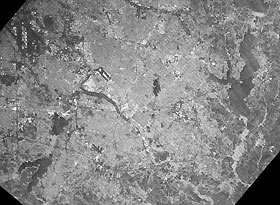
Enregistrez gratuitement cette image
en 800 pixels pour usage maquette
(click droit, Enregistrer l'image sous...)
|
|
Réf : V02126
Thème :
Terre vue de l'espace - Villes (375 images)
Titre : C-Band Radar Imagery, Dallas-Fort Worth, Texas
Description : (La description de cette image n'existe qu'en anglais)
The Dallas-Fort Worth metropolitan area in Texas is shown on this image collected by the C-band radar of the Shuttle Radar Topography Mission (SRTM). On this radar image, smooth areas, such as lakes, roads and airport runways appear dark. Rougher features, such as buildings and trees, appear bright. Downtown Dallas is the bright area at the center of the image, alongside the dark linear floodway of the Trinity River. Dark linear runways of two airports are also seen: Love Field near downtown Dallas in the image center, and Dallas-Fort Worth International Airport in the upper left corner. The semi-circular terminal buildings of the international airport can also be seen in the area between the runways. Several large lakes, including Lake Ray Hubbard (upper right) and Joe Pool Lake (lower left) are also seen. Images like these, along with the SRTM topographic data, will be used by urban planners to study and monitor land use, and update maps and geographic information systems for the area. This image represents just 4 seconds of data collection time by the SRTM instrument. The overall diagonal linear pattern is a data processing artifact due to the quick turn-around browse nature of this image. These artifacts will be removed with further data processing.This radar image was obtained by the Shuttle Radar Topography Mission as part of its mission to map the Earth's topography. The image was acquired by just one of SRTM's two antennas, and consequently does not show topographic data but only the strength of the radar signal reflected from the ground. This signal, known as radar backscatter, provides insight into the nature of the surface, including its roughness, vegetation cover, and urbanization.This image was acquired by the Shuttle Radar Topography Mission (SRTM) aboard the Space Shuttle Endeavour, launched on February 11, 2000. SRTM uses the same radar instrument that comprised the Spaceborne Imaging Radar-C/X-Band Synthetic Aperture Radar (SIR-C/X-SAR) that flew twice on the Space Shuttle Endeavour in 1994. The mission is designed to collect three-dimensional measurements of the Earth's surface. To collect the 3-D data, engineers added a 60-meter-long (200-foot) mast, installed additional C-band and X-band antennas, and improved tracking and navigation devices. The mission is a cooperative project between the National Aeronautics and Space Administration (NASA), the National Imagery and Mapping Agency (NIMA) of the U.S. Department of Defense (DoD), and the German and Italian space agencies. It is managed by NASA's Jet Propulsion Laboratory, Pasadena, CA, for NASA's Earth Science Enterprise, Washington, DC.Size: 35 km (21 miles) by 26 km (16 miles) Location: 32.82 deg. North lat., 96.67 deg. West lon.Orientation: North is towards the top Original Data Resolution: 30 meters (98 feet) Date Acquired: February 18, 2000
|
|

